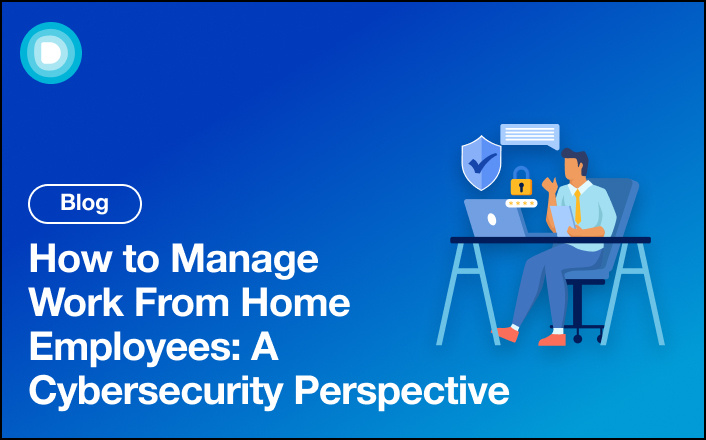- Product
-
Solution
-
By Industry
Cybersecurity solutions tailored to your industry’s needs.
-
- Resources
-
Books
Our ultimate guides and playbooks
Solution Briefs
Overview of PureDome’s functionality
-
Quizzes
Assess your cybersecurity readiness
Case Studies
PureDome customer success stories
Newsletter
Subscribe to the PureDome newsletter
-
- About Us
- Partner
- Pricing
- Download
How to Manage Work From Home Employees: A Cybersecurity Perspective
-
Aiman Ikram
-
27 May 2024
- 3 min read


It is reported that by 2025, 32.6 million Americans will work remotely. As more people work from home, keeping things safe online is super important. When employees use their own devices and internet connections, it can make a company's information vulnerable to hackers. This blog will give you easy tips on how to manage your remote team while keeping everything secure online.
Cybersecurity Risks in Remote Work Environments
- Unsecured Wi-Fi: Using public or unsecured Wi-Fi networks can expose sensitive data to hackers.
- Phishing Attacks: Employees may unknowingly click on malicious links or emails, giving hackers access to company systems.
- Weak Passwords: Using easy-to-guess passwords makes it easier for hackers to break into accounts and steal information.
- Unpatched Devices: Not updating software and security patches can leave devices vulnerable to cyberattacks.
- Shadow IT: Employees using unauthorized software or apps for work purposes can create security gaps.
- Physical Security: Lack of physical security for devices in home environments can lead to theft or unauthorized access.
- Data Leakage: Sharing sensitive information through unsecured channels or devices can result in data breaches.
- Social Engineering: Hackers may exploit trust to manipulate employees into revealing sensitive information or performing actions that compromise security.
Work From Home Cybersecurity: Key Insights
- 12.7% Full-Time Remote: About 12.7% of full-time employees work from home, while 28.2% adopt a hybrid model, balancing home and office work.
- 32.6 Million Remote Workers by 2025: It's estimated that by 2025, approximately 32.6 million Americans will be working remotely, constituting around 22% of the workforce.
- 98% Worker Preference: An overwhelming 98% of workers express a desire to work remotely at least some of the time, highlighting a strong preference for flexible work arrangements.

Establishing Secure Remote Access Protocols
Here are the top 8 best practices for establishing secure remote access protocols:
Implement Zero Trust Network Access (ZTNA): ZTNA ensures that access to resources is strictly controlled and authenticated, regardless of the user's location or device, minimizing the risk of unauthorized access.
Use Multi-Factor Authentication (MFA): Require users to provide multiple forms of verification, such as a password and a temporary code sent to their mobile device, before granting access, adding an extra layer of security.
Encrypt Data Transmission: Utilize strong encryption protocols (like SSL/TLS) to secure data transmitted between the user's device and the corporate network, safeguarding it from interception or eavesdropping.
Implement VPNs (Virtual Private Networks): VPNs create secure tunnels over the internet, allowing remote users to access corporate resources securely by encrypting their internet connection from end to end.
Regularly Update Software and Security Patches: Keep all remote access software, including VPN clients and security tools, up to date with the latest patches and updates to address vulnerabilities and protect against known threats.
Enforce Access Controls and Least Privilege: Limit access to sensitive resources based on the principle of least privilege, ensuring that users only have access to the resources necessary to perform their job duties, reducing the risk of data breaches.
Monitor and Audit Access Activities: Implement robust monitoring and logging mechanisms to track remote access activities in real-time, allowing administrators to detect and respond to suspicious behavior or security incidents promptly.
Provide Security Awareness Training: Educate remote users about common cybersecurity threats, such as phishing attacks and social engineering tactics, and train them on best practices for securely accessing corporate resources from remote locations.

What Should Be Included In A Security Policy for Remote Workers?
A security policy for remote workers should include guidelines on using secure Wi-Fi networks, avoiding suspicious emails or links, maintaining strong passwords, updating devices regularly, and safeguarding physical devices from theft or unauthorized access.
It should also outline procedures for reporting security incidents and provide clear instructions on using remote access tools securely. Additionally, the policy should emphasize the importance of cybersecurity awareness training to educate remote workers about potential risks and best practices for staying safe online.
How PureDome Helps
PureDome helps by providing a comprehensive cybersecurity solution that protects against various online threats. It offers features like firewall protection, intrusion detection, and malware scanning to keep your devices and networks safe from hackers and malicious software.
PureDome also offers user-friendly interfaces and intuitive controls, making it easy for individuals and businesses to manage their cybersecurity defenses effectively. With PureDome, you can have peace of mind knowing that your digital assets are secure and protected against cyberattacks.
Conclusion
In conclusion, safeguarding remote work environments against cybersecurity threats is paramount. By adopting best practices like ZTNA, MFA, and regular updates, alongside utilizing tools like PureDome, businesses can ensure data protection and operational continuity in the era of remote work.
Frequently Asked Questions
Why is cybersecurity important for remote work?
Cybersecurity is crucial for remote work because employees using their own devices and internet connections can make a company's information vulnerable to hackers.
What is ZTNA and why is it important?
ZTNA (Zero Trust Network Access) ensures strict control and authentication of resource access regardless of user location or device, minimizing the risk of unauthorized access in remote work environments.
How does PureDome help with cybersecurity?
PureDome provides a comprehensive cybersecurity solution, including firewall protection, intrusion detection, and malware scanning, to keep devices and networks safe from online threats in remote work settings.